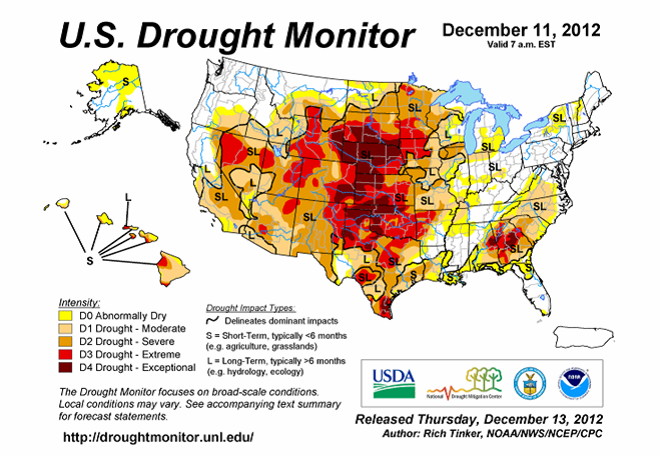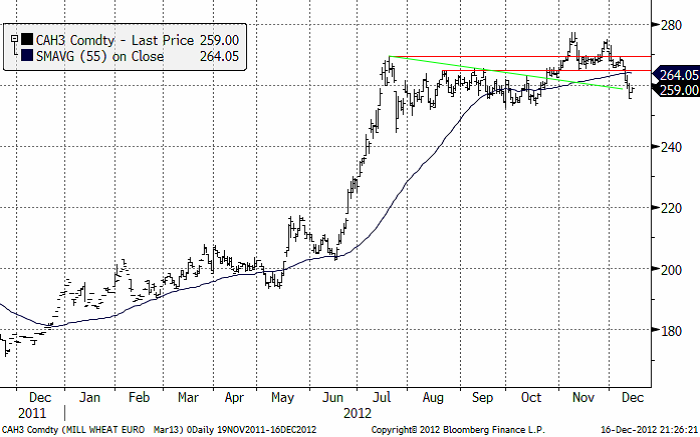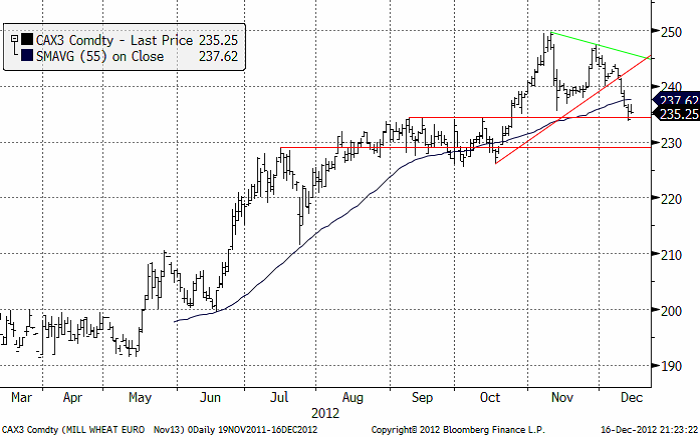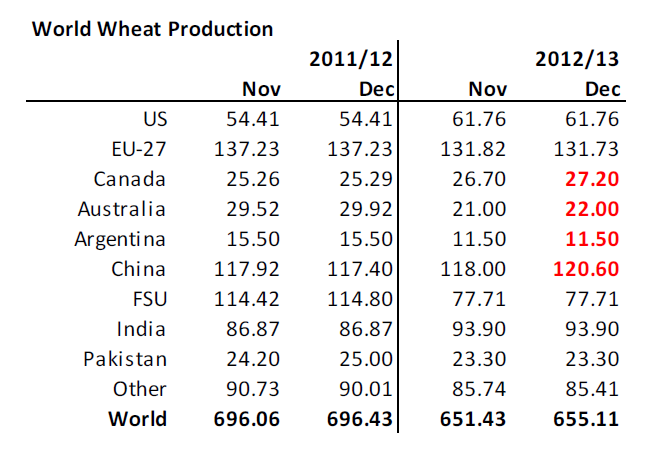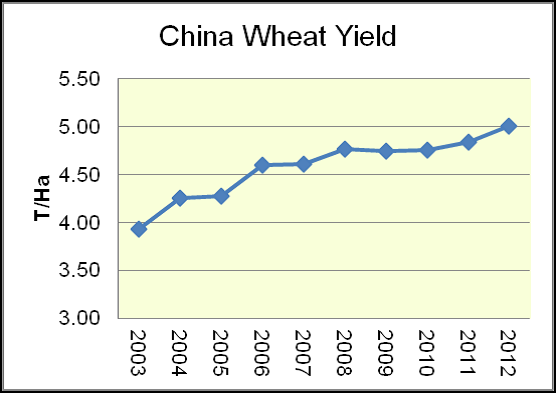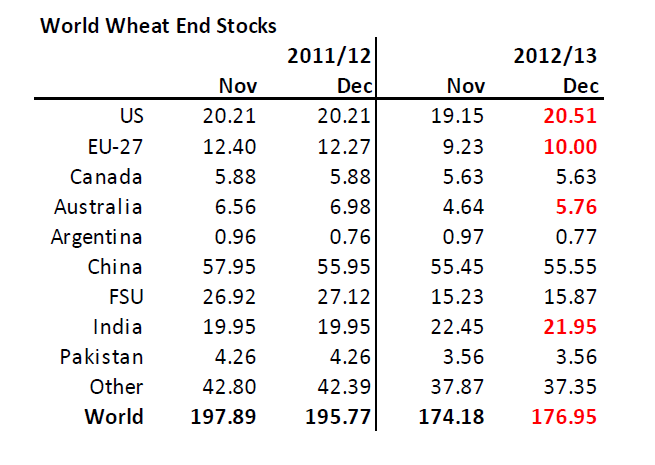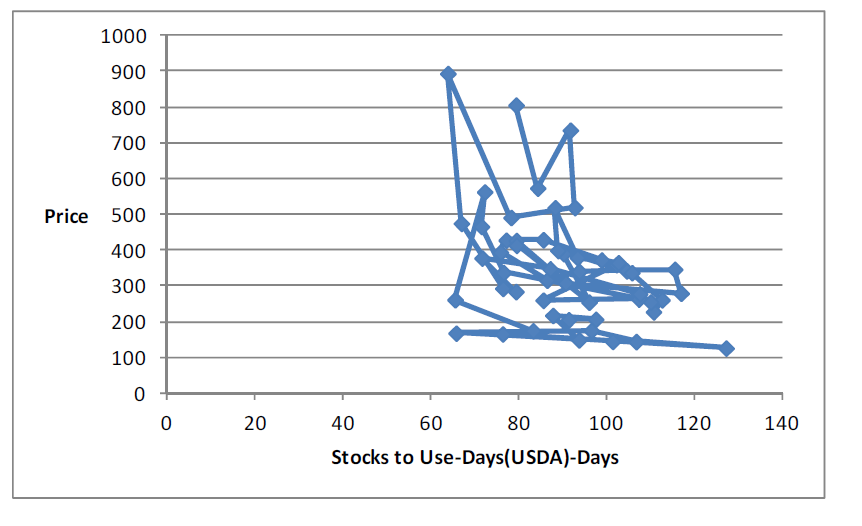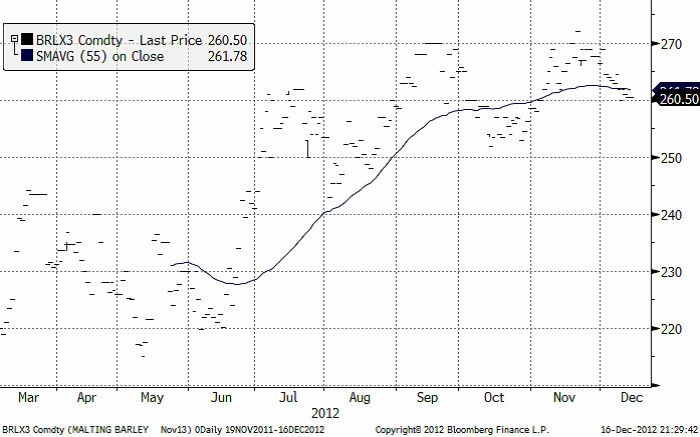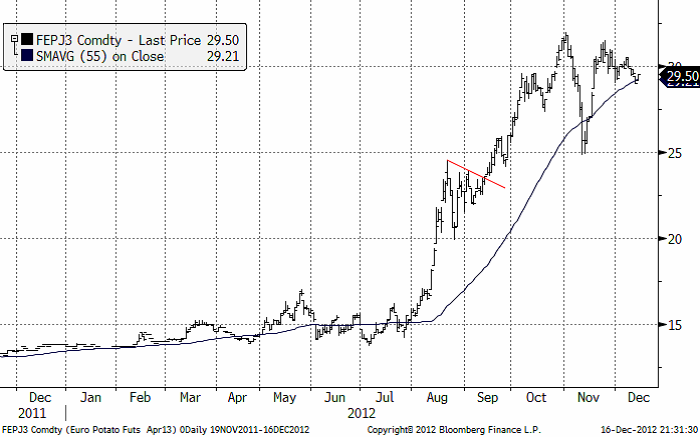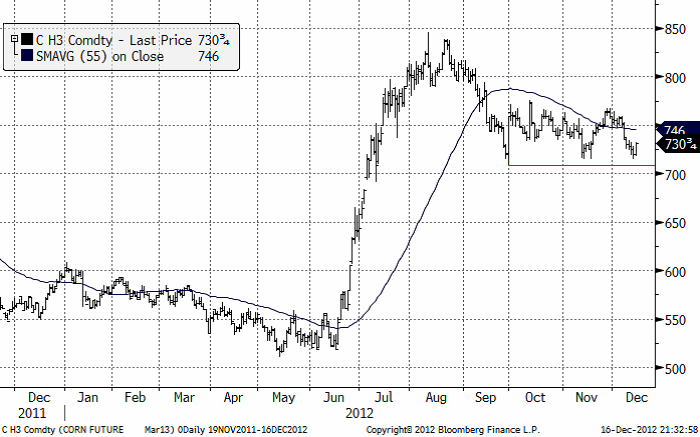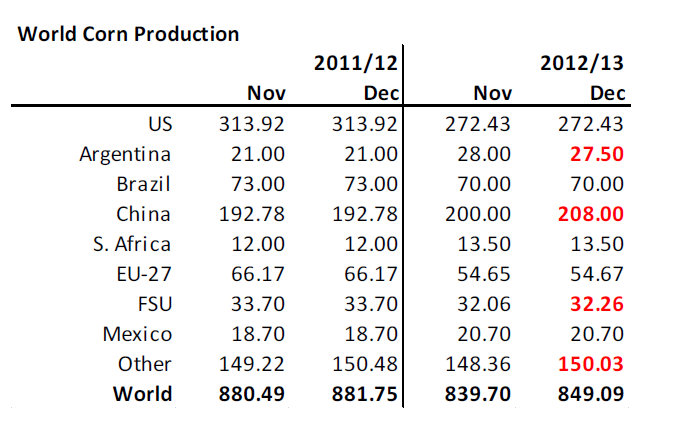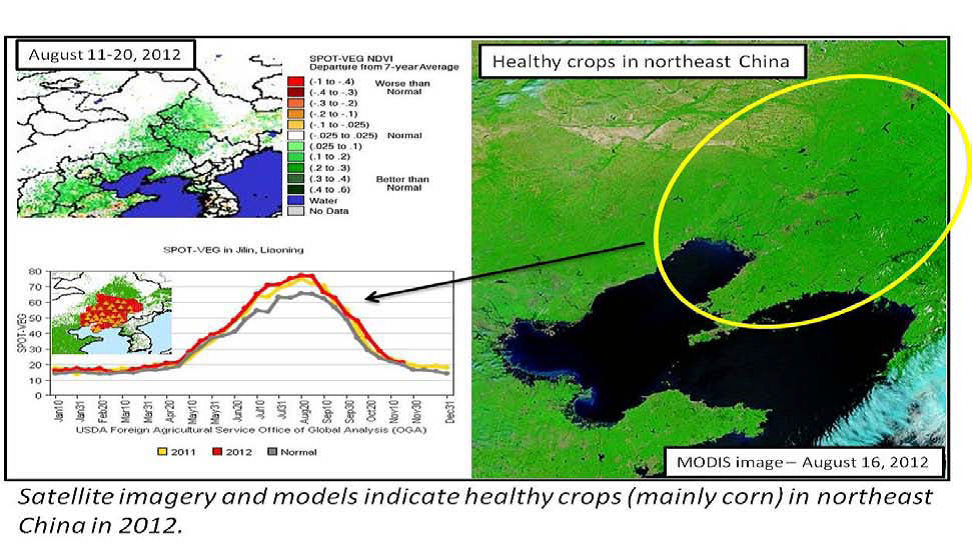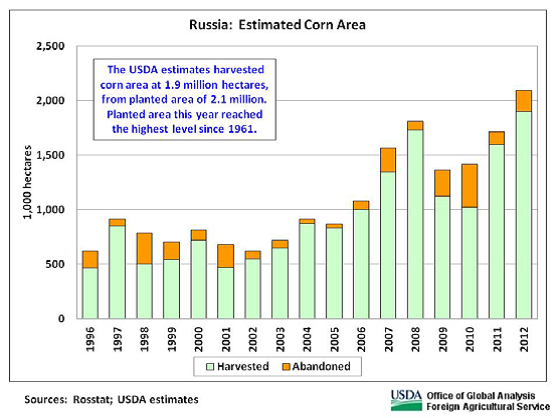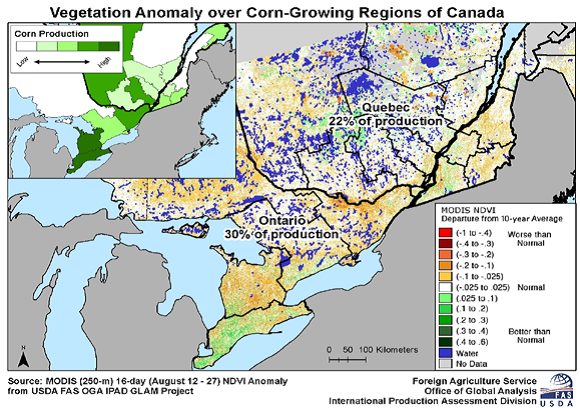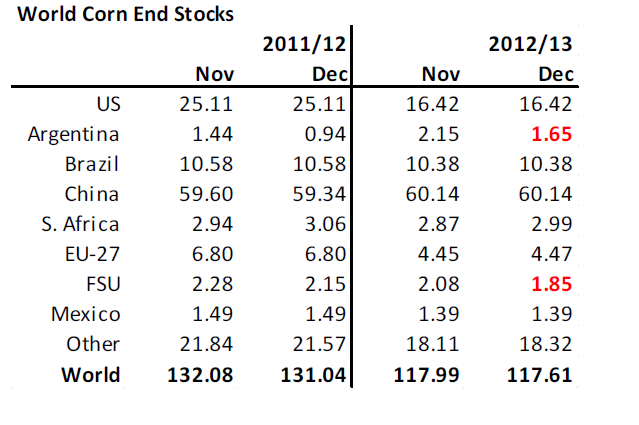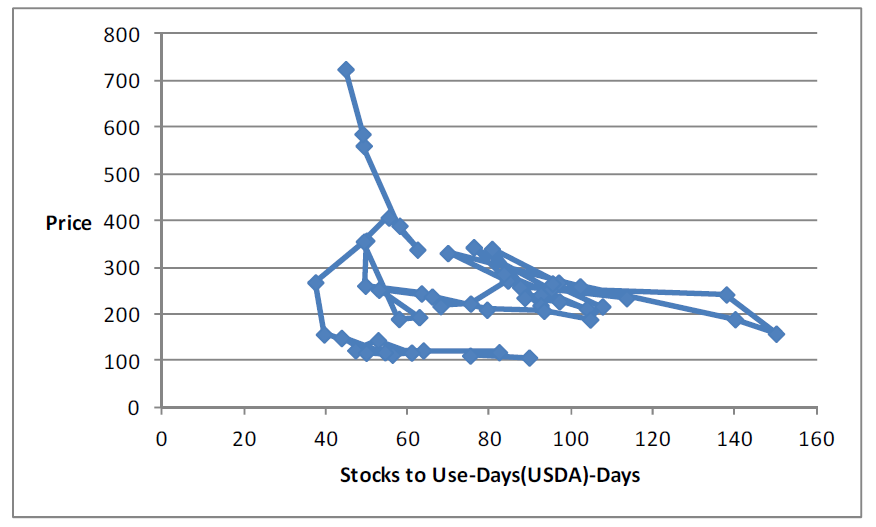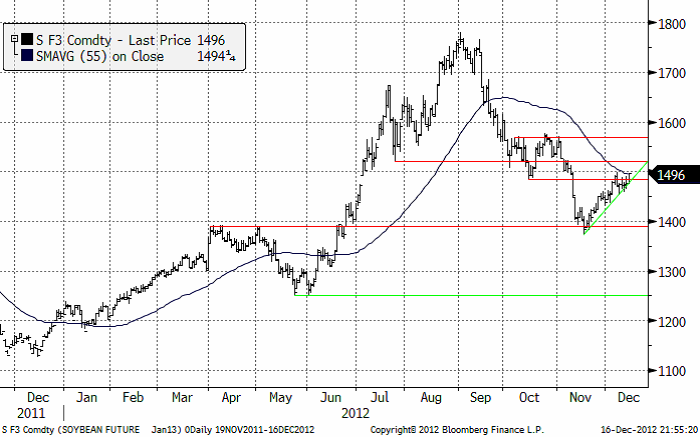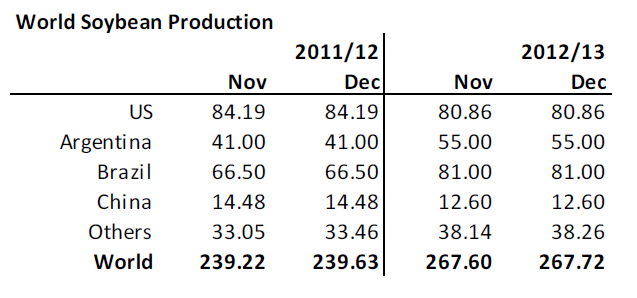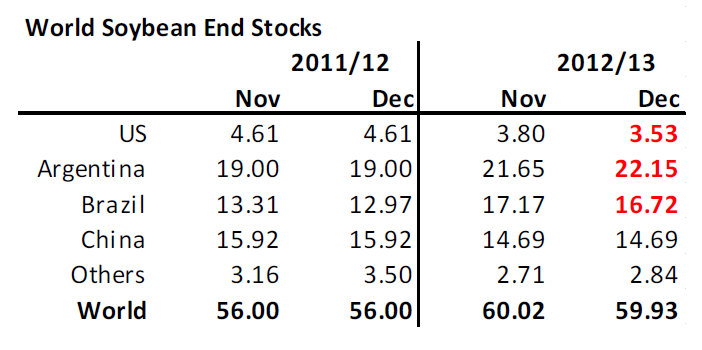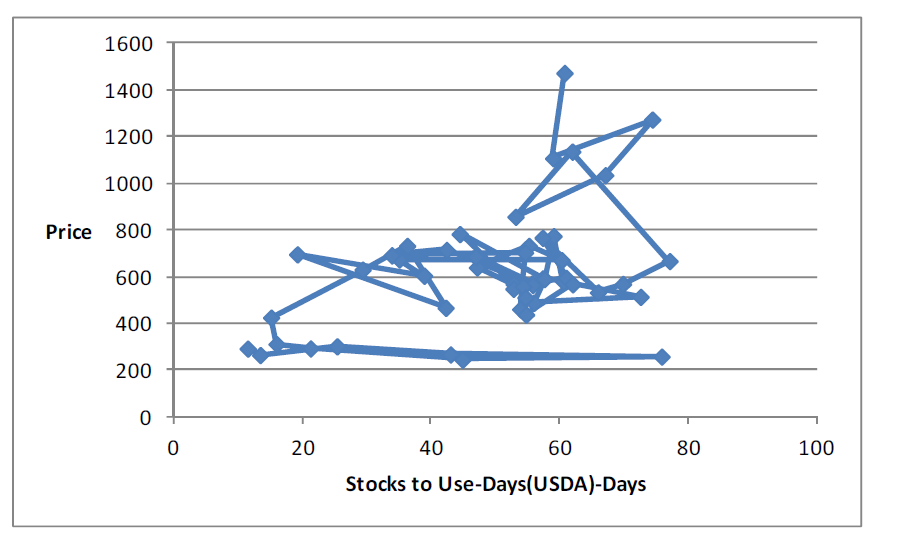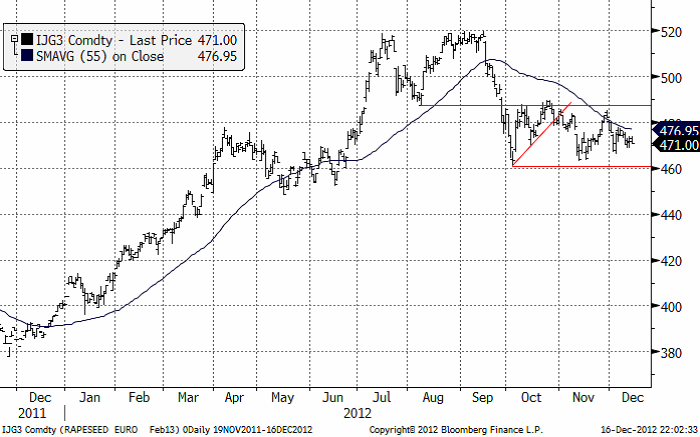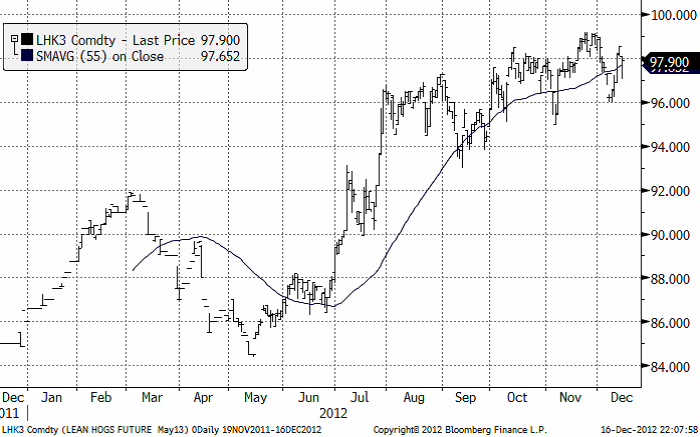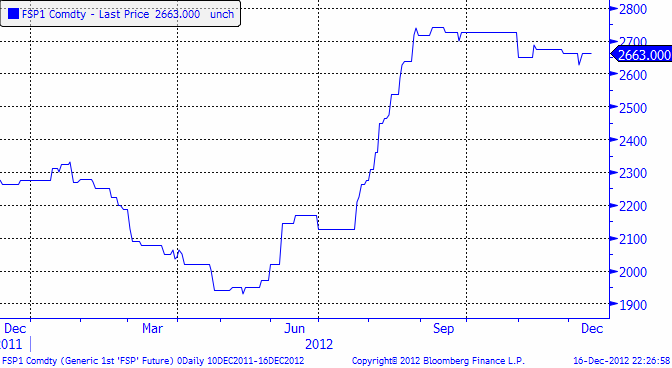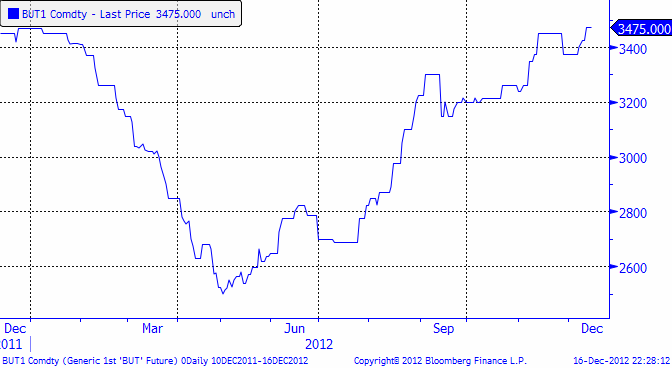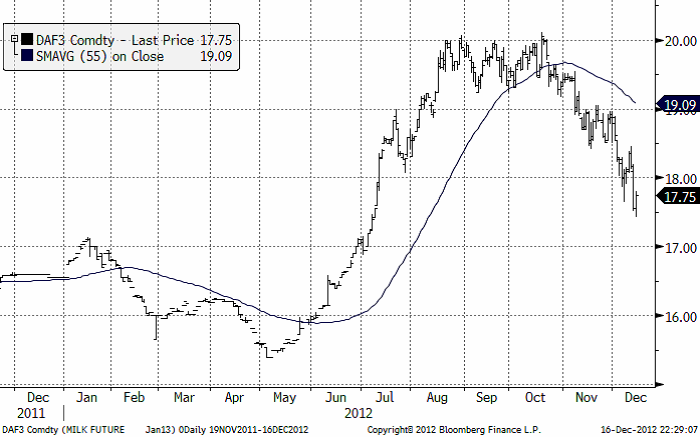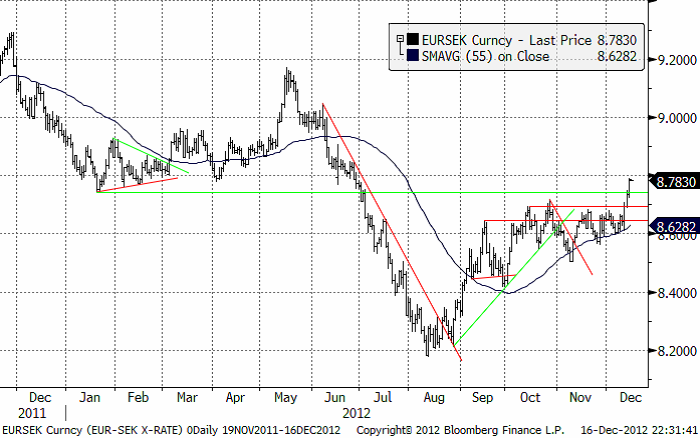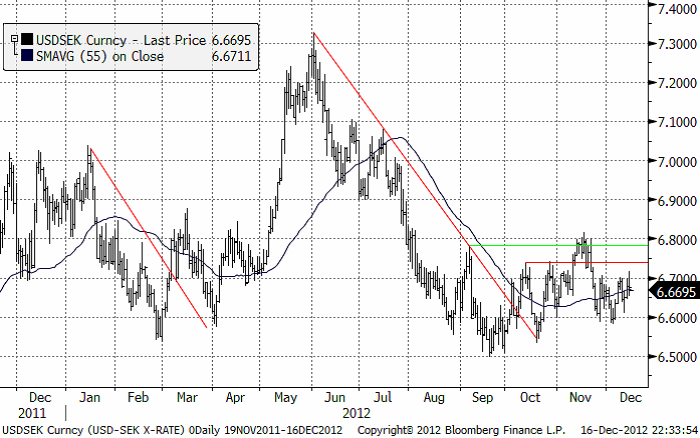Analys
SEB Jordbruksprodukter, 17 december 2012
 Vi byter rekommendation för vetepriset från ”köp” till ”sälj”. Visst finns chansen / eller risken, att det kommer ytterligare en prisuppgång, men den är i så fall sannolikt den sista innan priset vänder ner. Det kanske inte alls kommer någon prisuppgång, framåt februari, som en del talar om. Vi börjar tycka att det är dags att sluta hoppas på den sista uppgången, och istället positionera oss för den större prisnedgången.
Vi byter rekommendation för vetepriset från ”köp” till ”sälj”. Visst finns chansen / eller risken, att det kommer ytterligare en prisuppgång, men den är i så fall sannolikt den sista innan priset vänder ner. Det kanske inte alls kommer någon prisuppgång, framåt februari, som en del talar om. Vi börjar tycka att det är dags att sluta hoppas på den sista uppgången, och istället positionera oss för den större prisnedgången.
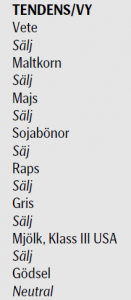 Vi ändrar också rekommendation på maltkornet från neutral till sälj och det betyder att vi har säljrekommendation för alla jordbruksprodukter. Majs ser för närvarande trendlöst ut, men sojabönorna som sakta rekylerat uppåt, ser redo att bryta nedåt ut. Efter den senaste WASDE-rapporten förefaller ”rätt pris” i förhållande till utgående lager, vara ca 200 cent / bushel lägre än dagens pris.
Vi ändrar också rekommendation på maltkornet från neutral till sälj och det betyder att vi har säljrekommendation för alla jordbruksprodukter. Majs ser för närvarande trendlöst ut, men sojabönorna som sakta rekylerat uppåt, ser redo att bryta nedåt ut. Efter den senaste WASDE-rapporten förefaller ”rätt pris” i förhållande till utgående lager, vara ca 200 cent / bushel lägre än dagens pris.
Odlingsväder
Det är fortsatt torrt mitt i USA, men det har regnat i södra USA. Europa är nu helt och hållet snötäckt där det ska vara det. Det är bara i södra Ryssland som det ännu inte finns snö.
Vete
Nedan ser vi mars (2013) kontraktet, där priset föll direkt när WASDE-rapporten blev känd. Priset har ännu inte fallit under oktober månads lägsta noteringar. Skulle priset göra det, får vi en bekräftelse på att en ny baisse-marknad för vete är inledd. Vi tror att det är en tidsfråga innan det sker.
Nedan ser vi kursdiagrammet för kommande skörd, november 2013. Priset bröt den uppåtgående stödlinjen vid strax över 240 euro per ton som en respons på WASDE-rapporten. Därefter har priset fallit ner till stödlinjen vid 235 euro. Där fanns köpare. Det är möjligt att det kommer en rekyl uppåt i veckan. Vi anser att den rekylen uppåt i så fall är ett säljtillfälle, och rekylen bör maximalt, enligt den tekniska analysen, gå upp mot 240 euro, men troligtvis inte över.
USDA’s uppjustering av utgående globala lager i decembers WASDE-rapport fick priset att falla både på Matif och i USA. Nedan ser vi produktionsestimaten i WASDE-rapporten:
Vi ser att USDA höjde skördeprognosen för 2012/13 med 4 mt. Uppjusteringarna gjordes för Kanada, Australien och Kina. Däremot gjorde man inte någon förändring för Argentina. USDA uppskattar Kinas vete produktion 2012/13 till 120.6 mt, vilket är en ökning med 2.6 mt från förra månaden. Den estimerade arealen på 24.14 miljoner hektar har justerats ned något medan estimerad avkastning justeras upp till rekordhöga 5.0 ton per hektar. Revideringarna bygger på de senaste officiella uppgifterna från Kinas National Bureau of Statistics. Enligt rapporter så visar de 11 största vete producerande provinserna högre avkastning 2012, vilket är det nionde året i rad med stabila eller stigande avkastningar. Gynnsamt väder under hela perioden, från sådd till skörd, har varit faktorn som bidragit till en rekordskörd av höstvete 2012.
Även Australiens produktion av vete 2012/13 justeras upp med 1 mt till 22 mt av USDA, medan arealen lämnas oförändrad.
USDA’s estimat för EU-27’s produktion av vete 2012/13 justeras ned marginellt från 131.82 till 131.73 mt. Revideringen beror på en nedjustering av produktionen i Frankrike. Nedan ser vi utgående lager, som väntas bli nästan 3 mt högre än i november månads WASDE-rapport. Till de viktigaste förändringarna hör att utgående lager väntas bli högre i de stora exportländerna USA och EU som helhet. Även i Australien väntas utgående lager bli högre. Detta tolkades av marknaden som negativt och fick priserna på fall. Detta sammanfaller med en förskjutning i sentimentet i marknaden. För många aktörer är frågan om huruvida det kommer (ännu) högre priser, eller om det är slut med haussen nu, mycket viktig och en källa till oro. Om dessa aktörer, stora spannmålshandlare och lantbrukare, börjar tro att det är slut på uppgången, finns sannolikt ett stort latent intresse från dem att sälja på dessa attraktiva priser, som det fortfarande är.
I diagrammet nedan ser vi priserna per stängning på WASDE-rapportdagen förra veckan och för tidigare års december-WASDE. Vi ser att priset ser högt ut, enligt den relation mellan lager och pris som har varit rådande de senaste åren. Priset på Chicagovete, som är det som visas i diagrammet, ser ut att ha ett mer ”rätt” pris, mellan 600 och 700 cent.
Sammanfattningsvis, det ser svagt ut tekniskt och priset ser högt ut i förhållande till väntade utgående lager. Därför byter vi från vår nu gamla köprekommendation från i somras och rekommenderar en såld position i vete. Möjligtvis kan en kortvarig rekyl uppåt komma med några euro per ton. Det är i så fall ett säljtillfälle.
Maltkorn
November 2013-kontraktet har fortsatt att falla i pris för andra veckan. Vi ser i diagrammet nedan att styrkan i marknaden successivt har avtagit sedan slutet av sommaren.
Potatis
Potatispriset för leverans i april har sjunkit något sedan förra veckan och handlas nu under 30 euro per dt. Även i potatismarknaden ser vi att styrkan i uppgången har avtagit de senaste månaderna.
Majs
Majspriset (mars 2013) föll mycket riktigt ner mot stödet, som ligger på 710 cent. I fredags hämtade sig priset och stängde nära dagshögsta. Det är svårt att säga om marknaden kommer att attrahera nya säljare i veckan som kommer, så att stödet testas igen, eller om det kommer en rekyl uppåt i veckan som kommer. I avsaknad av några större nyheter kanske marknaden fortsätter att röra sig ”sidledes” ett tag till.
USDA gjorde en ganska stor uppjustering av skörden 2012/13, som vi ser i nedanstående tabell. Möjligtvis sänkte man skörden för lite i Argentina, där det på grund av regnen är många som kommer att så sojabönor istället. De kan sås senare än majs. Annars skedde den stora uppjusteringen i Kina. Och det betyder att den nog inte är så säker. Man har tagit den officiella prognosen från Kina, rakt av.
Kinas majsproduktion 2012/13 uppskattas till rekordhöga 208 mt av USDA, en rejäl ökning jämfört med förra årets rekordskörd på 192.8 mt. Arealen för majs uppskattas till 34.9 miljoner hektar, en ökning med 1.4 miljoner från förra året. En stor del av ökningen i areal är bland annat på bekostnad av sojabönor, framförallt i Heilongjiang provinsen i nordöstra Kina, där lantbrukarnas intjäning på majs är betydligt högre än på sojabönor.
Avkastningen beräknas till rekordhöga 5.96 ton per hektar, och Kinas majs avkastning har haft en stigande trend under de senaste 10 åren och ökat med mer än 20 procent sedan 2003/2004. Riklig nederbörd har gynnat grödorna i de normalt torra regionerna i nordöstra och norra Kina, och omfattande bevattning har mildrat torkans effekter över den norra kinesiska slätten.
Även Rysslands produktion av majs 2012/13 estimeras till rekordhöga 8.5 mt av USDA, en ökning med 1 mt från förra månaden och upp 27 procent från förra årets rekordskörd på 6.7 mt. Avkastningen beräknas till 4.47 ton per hektar, vilket är 27 procent högre än det 5-åriga genomsnittet. En ökning av skördad areal är en bidragande faktor till den höga produktionen och beror på en kombination av faktorer, bland annat en ökad användning av majs som foder inom fjäderfäsektorn och ovanligt högt bortfall av 2012/13 års vintergrödor i södra Ryssland.
Canadas majs produktion 2012/13 justeras också upp till rekordhöga 13.1 mt av USDA, vilket är en ökning med nästan 1.5 mt från förra månaden. Arealen lämnas oförändrad på 1.42 miljoner hektar, vilket dock är en ökning med 16 procent från förra året, medan avkastningen på 9.20 ton per hektar är en minskning med 2.7 procent från förra året. Rekordhög skördad areal i både Ontario och Quebec, tillsammans med en högre avkastning i Quebec, har bidragit till rekord produktionen som en följd av gynnsamt varmt och torrt väder vid sådd.
Trots att man dragit till med 8 mt högre skörd i Kina, blir utgående lager oförändrade, som vi ser nedan.
Nedan ser vi utgående lager (prognosen) i förhållande till pris. Vi ser att majs aldrig varit så dyrt. Eftersom det inte finns några omkringliggande punkter (pris vs lager) att ta som referens, kan vi inte säga om priset är omotiverat högt eller inte. Bara att det högt.
Vi tror att priset borde komma ner, men det går inte att säga utifrån ovanstående relation om majs är ”felvärderat” idag, enligt förhållandet till utgående lager.
Sojabönor
Sojabönorna har fortsatt att handla högre med stödlinjen uppåt. Priset har kommit upp i motståndsnivåer. Det ”borde” vara slut på uppgången vid den här nivån. Vi rekommenderar därför sälj på sojabönor.
USDA lämnade produktions estimaten i princip oförändrade i förra veckans månatliga uppdatering av World Supply and Demand Estimates, WASDE.
Utgående lager justeras ned ytterst marginellt. Som vi ser är utgående lager i USA väldigt litet och ”borde” kanske ha sänkts mer, men det är ju näst intill omöjligt. Argentina justerades upp och Brasilien likaså.
Nedan ser vi var priset befinner sig i förhållande till utgående lager i termer av dagars konsumtion. Vi ser att priset ser kanske något högt ut i förhållande till relationen de senaste åren. Priset skulle kunna falla ner mot 1200 utan att det skulle vara ”fel” ur ett värderingsperspektiv, när man bara jämför med lager.
Till skillnad från majs, men i likhet med vete, ser priset på sojabönor högt ut i förhållande till väntade utgående lager. Även tekniskt ser det ut som om ett ”brott” nedåt är nära förestående. Vi rekommenderar en kort position i sojabönor.
Raps
Rapspriset (februari 2013) har fallit några euro sedan förra veckan. Det verkar som om rapspriset därmed tagit mer intryck av Matif-vetets fall, än sojabönornas uppgång. Som vi skrev ovan, är det inte uteslutet, utan ganska troligt, att det kommer en kortvarig rekyl uppåt i Matif-vetet, och om rapsen fortsätter att följa den marknaden, kan det komma en rekyl uppåt i majsen också. Sojabönorna tror vi bryter ner, kanske redan den här veckan, så mellan dessa krafter är det kanske ”sidledes” rörelse som blir följden för rapsen.
Gris
Grispriset (Maj 13) följer vi nu, när december 12-kontraktet förfaller. Det finns inte mycket mer att säga. Trenden uppåt är försvagad, liksom för alla jordbruksprodukter.
Mjölk
Priset på mjölkpulver på Eurexbörsen steg något sedan förra veckan.
Nedan ser vi priset på smör, som är lite starkare än marknaden för pulver och som fortsatt att stiga, nu till 3475 euro per ton.
Det börsbaserade priset i svenska kronor beräknas med formeln:
där
BUT = priset på smör i euro per ton
SMP = priset på skummjölkspulver i euro per ton
FX = växelkursen för EURSEK.
Nedan ser vi januari-kontraktet på amerikansk klass 3-mjölk, som föll ytterligare i veckan som gick. Det fanns ett stöd på 18 cent per pund, som marknaden föll rakt igenom. Nästa tekniska stödnivå finns på 17 cent. Priset stängde i fredags på 17.75 cent.
EURSEK
EURSEK har något oväntat brutit uppåt och noterat de högsta kurserna mot kronan sedan juni. Det finns emellertid starka motstånd vid dagens kursnivå, som gör att vi inte tror att priset går högre just nu. Trenden måste vi nog säga är uppåtriktad just nu.
USDSEK
Dollarna fortsätter att handlas ”sidledes”. 6.60 kr per dollar ser ut som ett stöd. Kursen har vänt upp från den nivån två gånger sedan månadsskiftet oktober/november. 6.70 ser likaledes ut som en motståndsnivå. Vid 6.80 ser vi ytterligare en motståndsnivå. Just nu ser det ut som om vi kan förvänta oss ännu mer ”sidledes” rörelse inom detta intervall.
[box]SEB Veckobrev Jordbruksprodukter är producerat av SEB Merchant Banking och publiceras i samarbete och med tillstånd på Råvarumarknaden.se[/box]
Disclaimer
The information in this document has been compiled by SEB Merchant Banking, a division within Skandinaviska Enskilda Banken AB (publ) (“SEB”).
Opinions contained in this report represent the bank’s present opinion only and are subject to change without notice. All information contained in this report has been compiled in good faith from sources believed to be reliable. However, no representation or warranty, expressed or implied, is made with respect to the completeness or accuracy of its contents and the information is not to be relied upon as authoritative. Anyone considering taking actions based upon the content of this document is urged to base his or her investment decisions upon such investigations as he or she deems necessary. This document is being provided as information only, and no specific actions are being solicited as a result of it; to the extent permitted by law, no liability whatsoever is accepted for any direct or consequential loss arising from use of this document or its contents.
About SEB
SEB is a public company incorporated in Stockholm, Sweden, with limited liability. It is a participant at major Nordic and other European Regulated Markets and Multilateral Trading Facilities (as well as some non-European equivalent markets) for trading in financial instruments, such as markets operated by NASDAQ OMX, NYSE Euronext, London Stock Exchange, Deutsche Börse, Swiss Exchanges, Turquoise and Chi-X. SEB is authorized and regulated by Finansinspektionen in Sweden; it is authorized and subject to limited regulation by the Financial Services Authority for the conduct of designated investment business in the UK, and is subject to the provisions of relevant regulators in all other jurisdictions where SEB conducts operations. SEB Merchant Banking. All rights reserved.
Analys
Tightening fundamentals – bullish inventories from DOE
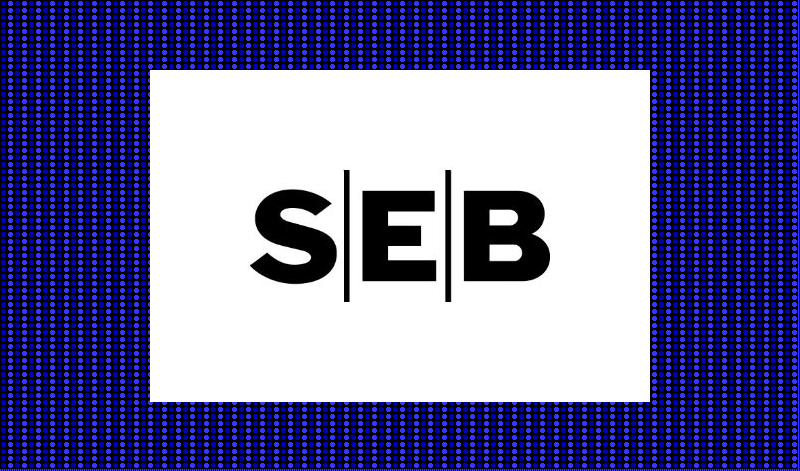
The latest weekly report from the US DOE showed a substantial drawdown across key petroleum categories, adding more upside potential to the fundamental picture.

Commercial crude inventories (excl. SPR) fell by 5.8 million barrels, bringing total inventories down to 415.1 million barrels. Now sitting 11% below the five-year seasonal norm and placed in the lowest 2015-2022 range (see picture below).
Product inventories also tightened further last week. Gasoline inventories declined by 2.1 million barrels, with reductions seen in both finished gasoline and blending components. Current gasoline levels are about 3% below the five-year average for this time of year.
Among products, the most notable move came in diesel, where inventories dropped by almost 4.1 million barrels, deepening the deficit to around 20% below seasonal norms – continuing to underscore the persistent supply tightness in diesel markets.
The only area of inventory growth was in propane/propylene, which posted a significant 5.1-million-barrel build and now stands 9% above the five-year average.
Total commercial petroleum inventories (crude plus refined products) declined by 4.2 million barrels on the week, reinforcing the overall tightening of US crude and products.
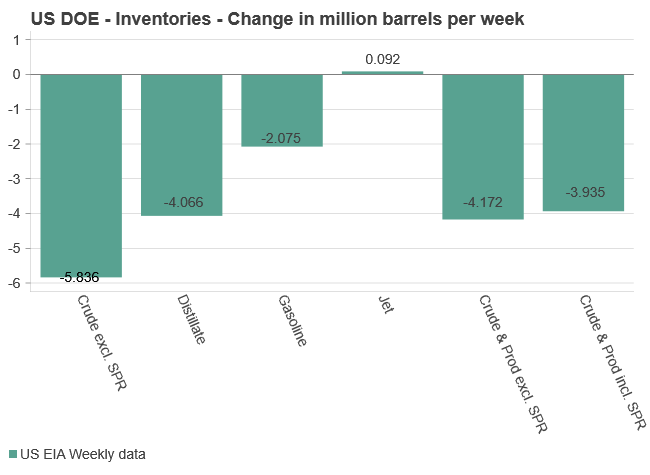
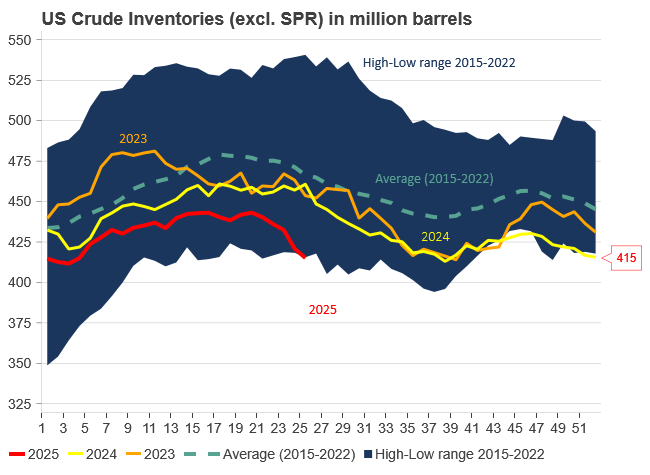
Analys
Bombs to ”ceasefire” in hours – Brent below $70

A classic case of “buy the rumor, sell the news” played out in oil markets, as Brent crude has dropped sharply – down nearly USD 10 per barrel since yesterday evening – following Iran’s retaliatory strike on a U.S. air base in Qatar. The immediate reaction was: “That was it?” The strike followed a carefully calibrated, non-escalatory playbook, avoiding direct threats to energy infrastructure or disruption of shipping through the Strait of Hormuz – thus calming worst-case fears.

After Monday morning’s sharp spike to USD 81.4 per barrel, triggered by the U.S. bombing of Iranian nuclear facilities, oil prices drifted sideways in anticipation of a potential Iranian response. That response came with advance warning and caused limited physical damage. Early this morning, both the U.S. President and Iranian state media announced a ceasefire, effectively placing a lid on the immediate conflict risk – at least for now.
As a result, Brent crude has now fallen by a total of USD 12 from Monday’s peak, currently trading around USD 69 per barrel.
Looking beyond geopolitics, the market will now shift its focus to the upcoming OPEC+ meeting in early July. Saudi Arabia’s decision to increase output earlier this year – despite falling prices – has drawn renewed attention considering recent developments. Some suggest this was a response to U.S. pressure to offset potential Iranian supply losses.
However, consensus is that the move was driven more by internal OPEC+ dynamics. After years of curbing production to support prices, Riyadh had grown frustrated with quota-busting by several members (notably Kazakhstan). With Saudi Arabia cutting up to 2 million barrels per day – roughly 2% of global supply – returns were diminishing, and the risk of losing market share was rising. The production increase is widely seen as an effort to reassert leadership and restore discipline within the group.
That said, the FT recently stated that, the Saudis remain wary of past missteps. In 2018, Riyadh ramped up output at Trump’s request ahead of Iran sanctions, only to see prices collapse when the U.S. granted broad waivers – triggering oversupply. Officials have reportedly made it clear they don’t intend to repeat that mistake.
The recent visit by President Trump to Saudi Arabia, which included agreements on AI, defense, and nuclear cooperation, suggests a broader strategic alignment. This has fueled speculation about a quiet “pump-for-politics” deal behind recent production moves.
Looking ahead, oil prices have now retraced the entire rally sparked by the June 13 Israel–Iran escalation. This retreat provides more political and policy space for both the U.S. and Saudi Arabia. Specifically, it makes it easier for Riyadh to scale back its three recent production hikes of 411,000 barrels each, potentially returning to more moderate increases of 137,000 barrels for August and September.
In short: with no major loss of Iranian supply to the market, OPEC+ – led by Saudi Arabia – no longer needs to compensate for a disruption that hasn’t materialized, especially not to please the U.S. at the cost of its own market strategy. As the Saudis themselves have signaled, they are unlikely to repeat previous mistakes.
Conclusion: With Brent now in the high USD 60s, buying oil looks fundamentally justified. The geopolitical premium has deflated, but tensions between Israel and Iran remain unresolved – and the risk of missteps and renewed escalation still lingers. In fact, even this morning, reports have emerged of renewed missile fire despite the declared “truce.” The path forward may be calmer – but it is far from stable.
Analys
A muted price reaction. Market looks relaxed, but it is still on edge waiting for what Iran will do

Brent crossed the 80-line this morning but quickly fell back assigning limited probability for Iran choosing to close the Strait of Hormuz. Brent traded in a range of USD 70.56 – 79.04/b last week as the market fluctuated between ”Iran wants a deal” and ”US is about to attack Iran”. At the end of the week though, Donald Trump managed to convince markets (and probably also Iran) that he would make a decision within two weeks. I.e. no imminent attack. Previously when when he has talked about ”making a decision within two weeks” he has often ended up doing nothing in the end. The oil market relaxed as a result and the week ended at USD 77.01/b which is just USD 6/b above the year to date average of USD 71/b.

Brent jumped to USD 81.4/b this morning, the highest since mid-January, but then quickly fell back to a current price of USD 78.2/b which is only up 1.5% versus the close on Friday. As such the market is pricing a fairly low probability that Iran will actually close the Strait of Hormuz. Probably because it will hurt Iranian oil exports as well as the global oil market.
It was however all smoke and mirrors. Deception. The US attacked Iran on Saturday. The attack involved 125 warplanes, submarines and surface warships and 14 bunker buster bombs were dropped on Iranian nuclear sites including Fordow, Natanz and Isfahan. In response the Iranian Parliament voted in support of closing the Strait of Hormuz where some 17 mb of crude and products is transported to the global market every day plus significant volumes of LNG. This is however merely an advise to the Supreme leader Ayatollah Ali Khamenei and the Supreme National Security Council which sits with the final and actual decision.
No supply of oil is lost yet. It is about the risk of Iran closing the Strait of Hormuz or not. So far not a single drop of oil supply has been lost to the global market. The price at the moment is all about the assessed risk of loss of supply. Will Iran choose to choke of the Strait of Hormuz or not? That is the big question. It would be painful for US consumers, for Donald Trump’s voter base, for the global economy but also for Iran and its population which relies on oil exports and income from selling oil out of that Strait as well. As such it is not a no-brainer choice for Iran to close the Strait for oil exports. And looking at the il price this morning it is clear that the oil market doesn’t assign a very high probability of it happening. It is however probably well within the capability of Iran to close the Strait off with rockets, mines, air-drones and possibly sea-drones. Just look at how Ukraine has been able to control and damage the Russian Black Sea fleet.
What to do about the highly enriched uranium which has gone missing? While the US and Israel can celebrate their destruction of Iranian nuclear facilities they are also scratching their heads over what to do with the lost Iranian nuclear material. Iran had 408 kg of highly enriched uranium (IAEA). Almost weapons grade. Enough for some 10 nuclear warheads. It seems to have been transported out of Fordow before the attack this weekend.
The market is still on edge. USD 80-something/b seems sensible while we wait. The oil market reaction to this weekend’s events is very muted so far. The market is still on edge awaiting what Iran will do. Because Iran will do something. But what and when? An oil price of 80-something seems like a sensible level until something do happen.
-

 Nyheter4 veckor sedan
Nyheter4 veckor sedanUppgången i oljepriset planade ut under helgen
-

 Nyheter3 veckor sedan
Nyheter3 veckor sedanMahvie Minerals växlar spår – satsar fullt ut på guld
-

 Nyheter4 veckor sedan
Nyheter4 veckor sedanLåga elpriser i sommar – men mellersta Sverige får en ökning
-

 Nyheter2 veckor sedan
Nyheter2 veckor sedanOljan, guldet och marknadens oroande tystnad
-

 Analys4 veckor sedan
Analys4 veckor sedanVery relaxed at USD 75/b. Risk barometer will likely fluctuate to higher levels with Brent into the 80ies or higher coming 2-3 weeks
-

 Nyheter2 veckor sedan
Nyheter2 veckor sedanJonas Lindvall är tillbaka med ett nytt oljebolag, Perthro, som ska börsnoteras
-

 Analys3 veckor sedan
Analys3 veckor sedanA muted price reaction. Market looks relaxed, but it is still on edge waiting for what Iran will do
-

 Nyheter2 veckor sedan
Nyheter2 veckor sedanDomstolen ger klartecken till Lappland Guldprospektering


